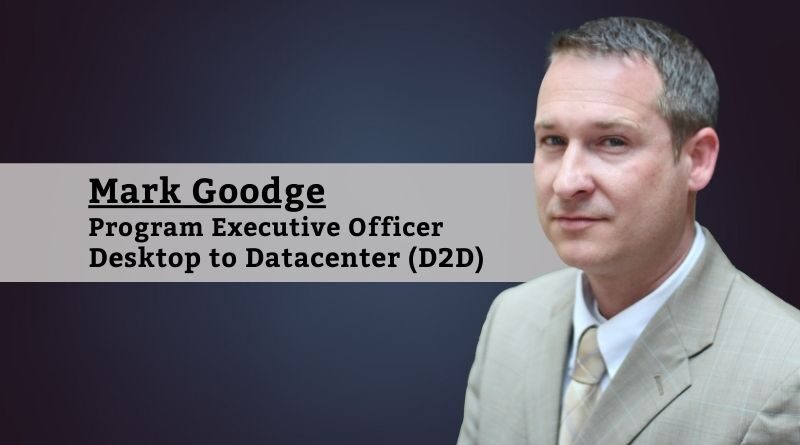How to Prepare the Military Health System for Modernization, Standardization, and Interoperability?
By Mark Goodge, Program Executive Officer of Desktop to Datacenter (D2D)
The Military Health System (MHS) is in the midst of a historical healthcare transformation to improve patient care for 9.6 million beneficiaries comprised of active service members, veterans, and their families. This initiative required significant enhancements to infrastructure, processes, and operations at more than 400 medical treatment facilities (MTFs) worldwide in order to deploy the new electronic health record (EHR) system – MHS GENESIS. The MHS GENESIS implementation enables medical providers and patients to securely access a single health record throughout the continuum of care from the point of injury to arriving at an MTF, regardless of location.
The success of the D2D program is a key enabler to the medical readiness of our warfighters and the well-being of their families.
A transformation of this magnitude does not occur overnight. In 2013, a directive from Congress charged the Defense Health Agency (DHA) with standardizing the information technology (IT) infrastructure and networks at MTFs, improving interoperability, and enhancing patient outcomes throughout the Army, Navy, and Air Force. To accomplish this goal, and in preparation for MHS GENESIS, the Desktop to Datacenter (D2D) Program was established. Upon implementation of the D2D program, MTFs will be hosted on the shared network — Medical Community of Interest (Med-COI) — comprised of a secure architecture to facilitate standardization across all MTFs. This will enable providers to login to any desktop and securely view patient records, and patients will have open lines of communication with providers and secure access to health records at any MTF globally. This modernization is the future of the MHS and is vital to sustaining a medically ready force and ready medical force.
Migrating MTFs through the D2D program and onto the Med-COI is a monumental task that requires numerous resources, including collaboration within the DHA, cooperation with MTF leadership and personnel, and continued funding from Congress. In 2017, the Program Executive Office Desktop to Datacenter (PEO D2D) was established to oversee health IT and the infrastructure implementation component of D2D.
The success of the D2D program is a key enabler to the medical readiness of our warfighters and the well-being of their families. It requires a tremendous amount of resources from hardware and software acquisition, contract management, implementation, testing, training, customer support to overall project management. The question became how to structure the PEO D2D to ensure the program’s success and, ultimately, MHS GENESIS. Taking a step back and planning the following elements from the beginning has contributed directly to the success of the implementation to date:
Extensive Preparation: The requirements, schedule, and resources necessary to achieve important milestones were considered and identified upfront. A timeline was developed and communicated to all stakeholders. Roles and responsibilities were clearly defined. An Integrated Master Schedule was created to track implementation timeframes for each MTF by region using this information.
Resource allocation: Within the PEO D2D, an Operations Center was established to provide global oversight for the management of IT integration and MTF transition through the D2D program to Med-COI. Special teams were assembled to monitor budgets, schedules, risks, and performance. Regional Operations Center Chiefs (ROCCs) were assigned to serve as a single point of contact for MTFs to resolve issues and communicate with leadership and other DHA teams. Surge support resources were also leveraged to deploy as necessary to keep the D2D program on track, particularly during COVID-19.
Enterprise Training: Training continues to be an essential component of the D2D program before, during, and after the migration. A D2D Academy was created to train MTF Chief Information Officers (CIOs) and IT personnel to successfully transition their sites to the DHA Enterprise and prepare for the MHS GENESIS deployment. The D2D Academy was developed using lessons learned from previous deployments and focuses on technical, programmatic, and procedural aspects of IT services with the DHA. Updated information is delivered by nearly 30 DHA Subject Matter Experts every quarter. Training is provided through standardized classroom-based and virtual sessions, as well as through an on-demand web-based system. The Academy concept is evolving into a “Just-In-Time” program to train new IT leaders and professionals.
Communication: Regular and transparent communication was provided to site CIOs via teleconferences and kick-off briefings. Online tools have been leveraged for personnel to engage with the D2D team and maintain an open dialogue before and after the migration to ensure successful deployments. D2D teams established standing weekly meetings with site CIOs to understand new challenges and limitations experienced by MTF personnel and resolve conflicts. Through these discussions, processes were revamped, and lessons learned were documented and shared.
People: At the end of the day, our people have made the difference. The teams within the DHA and at the MTFs that collaborate to deliver the D2D program are passionate, dedicated, and united in the DHA’s mission to lead the MHS as an integrated, highly reliable system of medical training, readiness, and health.
The development of the PEO D2D was and continues to be instrumental to the success of the program. We are proud of the work accomplished to improve healthcare throughout the MHS and acknowledge that it is only just beginning. As the D2D program concludes and the focus shifts to supporting MTFs through a market-based structure, we take with us the lessons learned and look forward to providing enhanced, standardized, and integrated medical care to our service members and their families.




Pingback: MHS PEO D2D discusses How to Prepare the Military Health System for Modernization, Standardization, and Interoperability - FedHealthIT, a service of MileMarker10